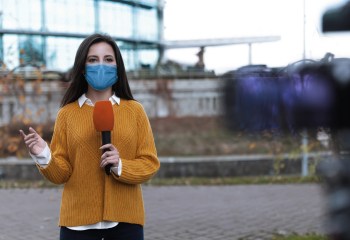
3 Ways Local News Initiatives Are Serving Crucial COVID-19 Information to People in News Deserts
Engagement collaborations, texting platforms, community media are trying to reach people in underserved communities where journalists are scarce.
Living in San Francisco, I have a lot of news sources to find out how the coronavirus is affecting my community. There’s the main San Francisco Chronicle website and app, which has provided COVID-19 case maps down to the ZIP code, and recently has been tracking which counties can reopen businesses. There’s also a full complement of local TV news, local public radio, and even neighborhood news sites, parent email lists and of course Nextdoor. Basically, I live in a news ocean.
By comparison, a colleague of mine lives in Scotland County, North Carolina, one of the poorest in the state, which is just six miles from the border with South Carolina. Scotland County lacks good newspapers and all the local TV stations are located in South Carolina. Her only reliable source of news on COVID-19 is the national map that runs in the New York Times that includes her county, and The Pilot newspaper in the next-door county. Ironically, she is Penny Abernathy, who has popularized the concept of “news deserts” with her research as a professor at the University of North Carolina, including her ubiquitous news desert map.
In her newest iteration of the map and data, Abernathy counted 500 counties in the U.S. without a daily newspaper, and 1,540 counties (half of all counties) with just one newspaper, usually a weekly. She found that since 2004 the U.S. has lost fully one-fourth of its newspapers, with a net loss of 2,155 of them. According to Abernathy’s report: “Many of the country’s 6,700 surviving papers have become ‘ghost newspapers’ – mere shells of their former selves, with greatly diminished newsrooms and readership.”
The situation for people in news deserts is dire, and even worse during a pandemic, when timely information is a matter of life and death. That’s compounded by “COVID-19 test deserts,” as a new report from Castlight found that 56% of U.S. counties have zero coronavirus test sites. And even in more urban and suburban areas with immigrant communities, access to timely COVID-19 information in their native languages can be scarce.
Ethnic media has been helping to fill the gaps, along with collaborations between community nonprofits and local news organizations. But communities of color have been hit disproportionately hard by COVID-19 infections and deaths, and a McKinsey analysis found that black Americans are “almost twice as likely to live in the counties at the highest risk of health and economic disruption.”
So what can be done to better reach people in news deserts and immigrant communities?
Here are three ways that journalism projects are reaching people in news deserts and immigrant communities with crucial COVID-19 information.
1. Texting services such as GroundSource, Subtext and Outlier
People living in news deserts might not have a daily newspaper or local TV news, but they likely have cell phones, like 96% of Americans (with 81% having smartphones). Those people are reachable by text message, and some news organizations are taking advantage of text platforms to broaden their audience and serve people in news deserts.
GroundSource is the oldest platform, initially set up to deliver more news sources for public media, and now focused on better engagement with threaded text questions. Outlier Media is a text service that uses GroundSource to cover local issues related to housing and utilities, and has grown from Detroit to Chicago with New Jersey coming next. And Subtext is a newer text platform from Advance Media’s Alpha Project that focuses on local reporters creating private text conversations with readers who can ask questions directly – and privately – to the reporter. People typically pay $5 per month to subscribe to a reporter’s Subtext feeds.
Rachel Hubbard, executive director of KOSU, a public radio network in Oklahoma, says they have been using GroundSource since the 2016 election to try to reach underserved parts of the state, including rural and Native American people.
“We selected four communities in Oklahoma that are rural communities, because we had a lag in our rural audience since the 2016 elections,” Hubbard said. “The number of reporters continues to decrease [around the state], and newspapers are becoming ‘ghost papers’ and aren’t doing the kind of local news that people are used to…Are we the single answer? No. Can we do something? Probably. We hear from people in rural areas that the media only comes when a tornado comes to town and leaves when the tornado leaves.”
Hubbard noted that people in news deserts often depend on Facebook Groups for local news, and that can lead to rumors and misinformation. In one case, there was a widespread rumor that a man who had COVID-19 was going around coughing on people, causing a hot spot in Mangam, Okla. It turned out that the real reason there was a hot spot was because of an outbreak in a nursing home. As Hubbard pointed out, there was no local radio news there, and no information coming from the state or county government.
KOSU typically uses texting to ask questions to people in these areas—on topics in the past related to elections, vaping and open carry of guns. They get quotes to use in stories and can follow up for more information from the sources. Now they are pivoting to not just asking questions but providing coronavirus information, and will be using GroundSource for texting, with a number sent out with mailers.
KOSU is part of the larger America Amplified project, a national community engagement project funded by the Corporation for Public Broadcasting, including a collaboration between eight public media networks. It was created to help public media better cover the 2020 elections by including diverse voices, but has now focused on coronavirus coverage, with a weekly call-in radio show on COVID-19.
Kathy Lu, the digital and social media editor for America Amplified, told me that they have used GroundSource for the talk show recently to find out how people feel about reopening businesses in communities. She liked the way you can ask a series of questions via text, creating a kind of automated conversation.
“With the proliferation of people getting marketing messages through text, there’s less of a barrier, you don’t have to fill out info on a website or fill out a form,” said Lu. “The great thing about texting is once you have the person in the system, you can reach back out to them. It’s a good way to develop a relationship with them.”
Lu mentioned that some America Amplified partners are also using Subtext to help build audiences via texting for reporters—as well as trust for the reporters. “StateImpact Pennsylvania is planning to send out a few reporters to more rural communities,” Lu said, “and will share the Subtext number to say, ‘I’m a reporter in your community and I’ll be focusing on covering it the rest of the year. And you can join this text group to communicate with me and we can share stories and resources with you, and you can tell us what’s going on.’”
David Cohn is the senior director at Advance Digital who is helping to shepherd Subtext to more local reporters. He says Subtext is launching six texting campaigns with America Amplified, including one helping Mission Local serve the Spanish-language community in San Francisco’s Mission District, and another serving coronavirus news for Rappahannock News in Virginia.
“If the location of a food bank or testing site changes, or local officials have made new pronouncements, text is the best way to inform an audience on their terms,” said Cohn. “When the information is critical, you want a medium that is familiar, requires no logins, avoids algorithms and social clutter with a 95% open rate. Luckily there’s just such a medium and it’s becoming easier and more affordable to use.”
2. Immigrant media and public access TV
In many immigrant communities, the mainstream local news outlets and public health department often don’t translate the news into their native language. That leaves a lot of people unsure about local lockdowns, what businesses are open and the severity of COVID-19. But many immigrant media outlets have been serving crucial information during the pandemic, whether it’s live-streaming video reports or updates via WeChat.
Daniela Gerson, the West Coast executive director of the Center for Community and Ethnic Media, told me she was amazed at the efforts of the top immigrant media outlets around the country, which were described in great detail in a recent report, “Digital First Responders.”
Jambalaya Radio in New Orleans on YouTube
“Some efforts are nothing short of heroic, what you’re seeing from these news outlets to connect with communities,” Gerson said. “Jambalaya Radio in New Orleans, the women there are incredible, not receiving salaries themselves, and spending all their time in the station answering questions. They are a live response forum, with people asking questions and then getting answers from experts in an immediate and tangible way. They are using digital media, particularly live-streaming, mostly over Facebook, but also and over radio platforms like TuneIn and social media, and WeChat and others that go beyond what is traditionally thought of in the U.S. as social media.”
Gerson noted that a Bangladeshi radio station in Corona, Queens, called TBN24 has become an incredible source of around-the-clock coverage for the immigrant community there that’s been hit hard by COVID-19. “What struck me the most is the way these outlets are providing a two-way conversation,” she said. “There’s an incredible amount of information being shared.”
Immigrant communities don’t have a lot of trust in institutions, so their community media often helps build a bridge to trusted information. Mike Wassenaar, president and CEO of the Alliance for Community Media, made up of 3,000+ community media outlets and public-access TV channels, said that he’s seen the success of a health partnership in St. Paul, Minn., with Twin Cities Public TV and cable access TV co-producing health information in different languages for the past 20 years.
“So you build trust with the community that way,” Wassenaar said. “As opposed to dropping down from Mars and saying ‘we’re the government and we’re here to help.’ Nobody naturally trusts the voice of institutions. You have to build trust over time.”
Community media has been suffering from the shutdowns around the country, with loss of revenues from advertising and sponsorships, as well as potential loss of subsidies from cable companies that have been shedding subscribers. But Wassenaar is heartened by the amazing work being done to cover civic and health issues during the pandemic by community media outlets in so many places, from Vermont to Maui.
In news deserts, these Public, Educational and Governmental (PEG) access stations might be the only source of timely local news, and they often run media training programs to get community members involved. Wassenaar notes how Vermont PEG stations are providing COVID-19 updates to very rural areas, and covering government meetings that weren’t getting coverage on local broadcast outlets.
“Newspaper reporters don’t go to open meetings any more so they depend upon the PEG station recordings on what’s happening with local government across the country,” Wassenaar said. “It’s the glue that’s necessary for small shops and operations, and they could be in rural or even suburban environments, which also qualify as news deserts, being in the shadow of major urban markets.”
Akaku.org, Maui Community Media, operates three cable access TV stations and a low-power radio station serving the three islands of Maui, Lanai and Molokai. Jay April, president and CEO of Akaku, told me that many people rely on Akaku as their main source of local news.
When COVID-19 hit, he said, “we decided to transform our entire operation to a news operation and every day we mobilize and produce a half-hour newscast that’s top heavy with coronavirus information. We gather information from state and local health officials and keep our eye on politicians. It’s like The Three Stooges out in Hawaii. The contradictory information that comes out of the government is insane… We separate the wheat from the chaff, and aggregate news from other sources but always credit the source.”
According to April, the staff has become grizzled news veterans in just a couple months. April’s assistant is now a TV anchor, and the staff is producing stories that “mean something to our community.”
3. Community engagement and virtual town halls
Often, people in underserved communities feel left out of news coverage by local media. The News Voices project at Free Press was started five years ago to bring community members together with local journalists so they could better understand each other, and broaden the voices in media stories. One of their biggest strategies was creating face-to-face events where people could meet and build deeper relationships and trust. But after the coronavirus hit, News Voices was challenged to create a similar experience online, according to Mike Rispoli, director of News Voices.
The solution was having virtual town halls to help journalists hear from the communities they are supposed to serve. “In Newark, Atlantic City, Philadelphia and Charlotte, we’ve hosted conversations in English and Spanish focused on what news you need to stay healthy and finding out what questions they have for newsmakers,” said Rispoli. “Most of these people don’t have access to news briefings, and we wanted to make sure their questions were being asked to decision-makers and we wanted to share stories of their communities’ character and resiliency too.”
In the case of the virtual town halls for Charlotte, some concerns were raised about issues with internet access. As Alicia Bell, a community organizer for Free Press, told Solutions Journalism Network’s Michael Davis in an interview, “A lot of folks were concerned about internet access. How would students have access? How would people working on the census have access? How would people who don’t usually telework get connected? The topic of internet access became both a possible education and a labor story.”
Another project aimed at serving underserved communities is the Listening Post Collective from Internews, which does an information ecosystem evaluation of a community and how they share news, trying to figure out what needs they have. The Collective has supported 20+ projects around the country, with many of them providing vital COVID-19 information to communities that are “often isolated from the news they need,” according to Listening Post Collective founder Jesse Hardman.
After doing their needs assessments, the Collective has gone on to help start a new Spanish-language newspaper and digital site for Fresno, Calif., called Ivanhoe Sol, and a new digital news site aimed at African American residents of Omaha, Neb., called NOISE Omaha, which recently received a grant from the American Journalism Project. Hardman noted that NOISE has launched an SMS service with updated COVID-19 information for their community.
Another Collective-supported project is the brand new Conecta Arizona, a news service for Spanish-speaking people in Arizona to get the latest coronavirus news via WhatsApp, Facebook and other social media platforms. The key to this project is community engagement, and having Phoenix journalist Maritza Félix running it. Félix herself is an immigrant from Sonora, Mexico, and she runs a daily “cafecito” with community members via WhatsApp to help answer their questions about the coronavirus.
But eventually the virtual town halls and online engagement will give way to real in-person engagement for people in news deserts. And on that front line are Susan Greene and Tina Griego of the Colorado Independent. They are putting their state-wide publication on hold and heading out to all parts of Colorado to provide support for deeper coverage of issues related to the coronavirus.
“We will be traveling the state and focusing largely on news deserts, and that definition is subjective because in some places the newspaper doesn’t provide deep information on COVID-19 or other issues,” Greene told me. “We will work with newspapers to do deeper dives around COVID-19 that they can’t do alone, because they don’t have the resources or skills for investigative work… We will work with them one-on-one so they get mentorship from us.”
Greene says that this is the most important story of our lifetimes so “we have to figure out a way to do it face to face and get into the humanity of it” even if it has to be with social distancing and wearing masks.
“There’s a lot of good will for what we’re doing,” Greene said, “and it’s really important when small papers are struggling and need to put reporters front and center, and develop the tools and do the journalism that’s indispensable.”
Watering the Deserts
It’s easy to get depressed about the state of local news when you look at news deserts maps and the growing number of layoffs and furloughs. But there is hope to be found in these growing initiatives that promote more community engagement, better understanding from journalists and vital information in the language of immigrants delivered to platforms that they already use.
Whether it’s a text service in Detroit or rural parts of Oklahoma, or immigrant media in Queens or community media in Maui, or virtual town halls or in-person reporting, these projects offer us the promise that more communities will get the information they need to understand the effects of the novel coronavirus.
Mark Glaser is a consultant and advisor with a focus on supporting local and independent news in America. He was the founder and executive director of MediaShift.org.
Recent Content
-
Journalismarticle ·
-
Journalismarticle ·
-
Journalismarticle ·





